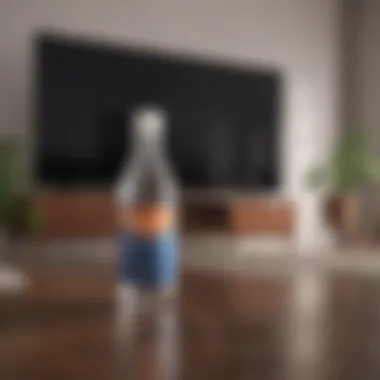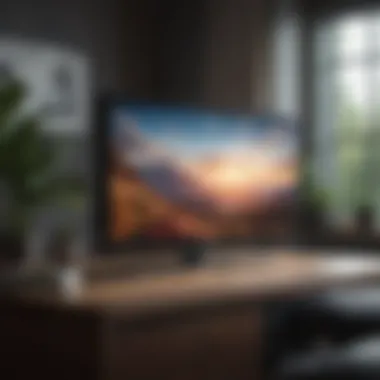Effective Methods for Cleaning Your LED TV Screen


Intro
Maintaining the cleanliness of an LED TV screen is crucial for preserving its clarity and functionality. A clean screen not only enhances your viewing experience but also prolongs the life of the television itself. Dust, fingerprints, and smudges can accumulate over time, leading to deterioration of picture quality. In this article, we will explore effective methods for cleaning LED TV screens, covering the best practices, materials, and tools needed to get optimal results without causing harm to the device.
Featured Homes
While this section traditionally focuses on architectural designs and stunning interiors, it serves as a reminder that just as we maintain our living spaces, we must also care for the devices that enhance our homes. An unblemished LED TV screen is akin to an elegantly designed living room; both deserve attention to detail.
Effective Cleaning Techniques
Cleaning your LED TV screen can be straightforward if done correctly. Here are some essential techniques to consider:
- Microfiber Cloth: The best option for cleaning. It is soft and won’t scratch the screen.
- Distilled Water: Use this instead of tap water to prevent mineral spots.
- Vinegar Solution: A mild solution can effectively cut through grime without damaging the screen.
Steps for Cleaning Your LED TV Screen
- Power Off: Always turn off your LED TV and unplug it before cleaning.
- Dust First: Use a dry microfiber cloth to remove dust in circular motions. Avoid applying force.
- Apply Cleaning Solution: Lightly dampen a cloth with distilled water or a vinegar solution. Do not spray directly on the screen.
- Wipe Gently: With the damp cloth, wipe the screen softly, following the screen's natural contours.
- Dry the Screen: Use another dry microfiber cloth to remove any excess moisture.
“Regular cleaning not only improves appearance but also maintains functionality.”
Cautions to Keep in Mind
Knowing what not to do is as important as knowing the right methods. The following actions should be avoided:
- Avoid Paper Towels: These can scratch surfaces.
- Never Use Harsh Chemicals: Avoid ammonia, alcohol, or strong cleaners.
- Do Not Apply Pressure: Excessive pressure can damage the screen.
Caring for your LED TV involves more than just keeping it clean; it's part of a routine that ensures it remains in top condition for as long as possible. By incorporating the practices outlined in this article, you will enhance not only your viewing experience but also the longevity of your device.
Understanding LED TV Screens
Understanding the specifics of LED TV screens is crucial for proper maintenance, including cleaning. LED screens are known for their vibrant colors, sharper images, and energy efficiency. Knowing how these screens work and their material composition helps in identifying the right cleaning techniques and tools. This section focuses on the essential elements that make LED screens unique, benefits of keeping them clean, and considerations for their maintenance. It’s important to note that improper cleaning can damage the screen and degrade image quality over time.
Composition and Characteristics
LED TVs, or Light Emitting Diode televisions, utilize LED technology for backlighting and display. They consist mainly of liquid crystal display (LCD) panels lit by LEDs. This technology allows for better contrast, improved color saturation, and lower power consumption compared to traditional LCD TVs.
- Key Components: The main elements of a LED TV include the LCD panel, LED backlight, and a glass screen. Each component plays a significant role in determining image quality and overall performance.
- Display Characteristics: The characteristics of LED screens include higher brightness levels, thinner designs, and the ability to display a wider color spectrum. The glass surface is smooth and can attract fingerprints and dust easily, which is why understanding how to clean them without causing harm is critical.
Common Types of LED Screens
There are various types of LED screens available in today’s market, and each has its own unique features. Here are a few common types:
- Standard LED: This type illuminates the screen using edge-lit LEDs around the perimeter, which offers a good balance of color and brightness.
- QLED: Quantum Dot LED screens utilize quantum dots to enhance brightness and color accuracy. These are popular for their vivid displays but require careful cleaning as their surface can be easily scratched.
- OLED: Organic LED screens provide stunning picture quality with deep blacks and excellent contrast. Their surface is more delicate compared to standard LED, making knowledge of the cleaning process extremely important.
- Mini-LED: This technology employs smaller LED lights. It creates more precise lighting effects and enhances contrast but also means that care during cleaning is essential to avoid damaging the finer technology.
Understanding these variations in LED screens helps in selecting appropriate cleaning methods. Each type may necessitate specific materials or techniques to maintain performance and longevity.
Why Cleaning is Essential
Cleaning your LED TV screen is not merely a matter of aesthetics. Dust and smudges can significantly degrade the visual clarity of your television. Over time, these obstructions can lead to a diminished viewing experience. For those who invest considerable amounts in their home entertainment systems, ensuring that the TV screen is clean becomes an essential part of maintaining that investment.
Impact of Dust and Smudges on Display Quality


Every minute particle of dust or fingerprint on your LED screen can disrupt the transmission of light. This interference can result in a dull picture, leading to poor color reproduction and reduced detail in images. When the screen is dirty, viewers may notice graininess or lack of focus, impacting their enjoyment of movies or shows. This distortion not only detracts from the visual experience but can also mean missed details in film and series. A clean screen, in contrast, offers sharp images and rich colors, providing a more immersive experience.
Benefits of Regular Maintenance
Regularly cleaning your TV screen can lead to multiple benefits:
- Prolonged Lifespan: Dust buildup can lead to overheating. This overheating can accelerate wear on internal components, reducing the life of the television.
- Improved Viewing Experience: A clean screen ensures that colors are bright and accurate, giving a full appreciation for the art of cinematography.
- Reduced Eye Strain: Accumulated dust can cause reflections, leading viewers to squint or strain their eyes. By keeping the screen clean, viewers can focus more on content without distraction.
In summary, routine cleaning of your LED TV is a straightforward yet crucial task, with a direct impact on both the quality of the viewing experience and the longevity of the device. Proper maintenance respects your financial investment while enhancing enjoyment.
Safe Cleaning Agents
Cleansing an LED TV screen requires caution, particularly regarding the choice of cleaning agents. Using the right cleaning supplies ensures that the display maintains its clarity and functionality while avoiding damage. Adopting safe cleaning agents can enhance the viewing experience and prolong the lifespan of the TV.
Microfiber Cloths: The Ideal Tool
Microfiber cloths stand out as the most suitable tools for cleaning LED screens. These cloths consist of tiny fibers that can pick up dust, oils, and smudges without scratching the surface. Unlike traditional dust rags, microfiber cloths trap dirt effectively. Moreover, they are reusable and washable, making them both economical and eco-friendly. It is essential to use a gentle touch when wiping the screen, as excessive pressure may lead to unwanted display issues.
Water: The Universal Solvent
Water often serves as the best and most straightforward cleaning solution. When using water, it is advisable to use distilled water, as it is free from minerals that may leave residues. Lightly dampening a microfiber cloth with water can effectively remove particles and smudges. Avoid dripping water directly onto the screen, as moisture can seep into the device and cause internal damage. Ensure to frequently check that the cloth is not too wet to prevent oversaturation.
Commercial Screen Cleaners: Pros and Cons
Commercial screen cleaners are available specifically designed for televisions. These products often boast formulated solutions to cut through grease and grime effectively. While they provide a convenient option, it is important to scrutinize their ingredients. Many harsh chemicals may cause more harm than good. Thus, the pros include effectiveness and ease of use, while the cons highlight potential risks to display integrity. Before utilizing any commercial cleaner, test it on a small, inconspicuous area first. This practice helps ensure compatibility with the screen material.
Always prioritize reading labels to understand the contents of any product before using it on your LED TV screen.
Cleaning Solutions to Avoid
Understanding which cleaning solutions to avoid is crucial for maintaining the integrity of LED TV screens. Not all cleaners are suitable for sensitive electronic displays. The wrong choice can lead to damage, rendering the screen less effective or even completely nonfunctional. By shedding light on appropriate practices in this section, readers will be empowered to make informed decisions that protect their devices from unintended harm.
Chemical-Based Cleaners
Chemical-based cleaners are often marketed as effective solutions for a variety of surfaces. However, they usually contain harsh components that are detrimental to LED screens. These chemicals can cause discoloration, cloudiness, or, worse, structural damage to the display. Popular cleaning agents like ammonia or alcohol might sound like viable options, but they can strip away protective coatings.
- Avoid ingredients such as:
- Ammonia
- Alcohol
- Strong detergents
Instead, opting for mild and specifically formulated products for electronic screens is advisable. This ensures that the delicate nature of the screen's surface is preserved while effectively removing dust and fingerprints.
Cloth Materials That Can Scratch
Not all cloths are created equal when it comes to cleaning screens. Using abrasive materials can lead to fine scratches that accumulate over time, significantly diminishing the viewing experience. Common fabrics like paper towels or rough cotton can leave behind micro-scratches. It is best practice to use soft microfiber cloths for cleaning.
Here are some tips to avoid using harmful cloth materials:
- Do not use:
- Paper products
- Cotton fabrics that are rough


Instead, prioritize using high-quality microfiber cloths. They are designed for gentle cleaning and do not compromise screen integrity. Always ensure that any cloth used is clean and dry before attempting to wipe the screen.
Using the right cleaning agents and cloths can prolong the life of your LED TV.
In summary, by avoiding harsh chemical cleaners and unsuitable cloth materials, users will significantly reduce the risk of damaging their LED TV screens. This understanding promotes better maintenance routines and a clearer television display.
Step-by-Step Cleaning Process
Cleaning your LED TV should not be a hurried task. Taking time to follow a methodical process will not only enhance your viewing experience but also prolong the life of the screen. This section provides a structured approach to cleaning, ensuring that you effectively remove dust and smudges without causing damage.
Preparing the TV for Cleaning
Before you start, it is crucial to prepare the television. Start by turning off the TV and unplugging it from the outlet. This reduces any risks associated with electrical hazards during the cleaning process. Let the screen cool down, as hot surfaces can be sensitive to cleaning agents. Then, gather your cleaning materials, including a soft microfiber cloth and, if needed, a small spray bottle filled with distilled water.
Next, examine the screen for any noticeable spots or stains. Recognizing the condition of the surface allows you to address each issue properly. It is also wise to dust the area around the TV to prevent any additional grime from settling onto the screen while you clean.
Techniques for Effective Cleaning
Use gentle techniques to clean the screen. Dampening the microfiber cloth with distilled water is often sufficient for removing most dust and smudges. Ensure the cloth is not overly wet, as excess moisture can seep into the device and cause damage.
- Wipe in Circular Motions: Start from one corner of the screen and slowly move towards the opposite side in circular motions. This method helps prevent streaking on the surface.
- Use Minimal Pressure: Applying too much force can lead to scratches. Simply glide the cloth gently across the screen, allowing it to lift dirt without damaging the display.
- Address Stubborn Marks: For sticky residues, dampen the cloth slightly more and hold it on the mark for a few seconds before lightly wiping it away. If necessary, a small amount of distilled water mixed with white vinegar can be helpful, but avoid harsh chemicals.
Ensuring Drying and Maintenance
After cleaning, ensure that the screen dries properly. If you notice any dampness, use a dry part of the microfiber cloth to wipe off any remaining moisture. Avoid turning the TV back on until the screen is completely dry.
Regular maintenance is just as important. Set a schedule for cleaning to prevent buildup. A monthly clean can keep the screen looking fresh and reduce the effort required in subsequent cleanings. Keeping the surrounding environment clean also helps.
Special Considerations
When cleaning your LED TV screen, there are several special considerations to keep in mind. These considerations ensure that you do not inadvertently damage your screen or reduce its lifespan. Everyone has different screen types, each requiring unique approaches. Moreover, sticky residues can accumulate on screens for various reasons, and knowing how to address them is critical.
Cleaning Different Screen Types
Various types of LED displays are common in households today. Some screens may come with a glossy finish, while others might have a matte surface. Understanding these differences is crucial to avoiding damage. For instance, glossy screens tend to show fingerprints and smudges more readily than matte screens, which can obscure visibility.
Here are some tips for cleaning different types of screens:
- Glassy Screens: Use a microfiber cloth dampened with water. Avoid strong cleaning solutions that can create streaks or scratches.
- Matte Screens: These can be more robust. A mixture of water and a small amount of vinegar can help lift stubborn dirt.
- Smart TVs: Often have additional coatings for touch control or glare reduction. It's best to consult the manufacturer's cleaning recommendations.
- Older LED Models: They may require gentler techniques since their displays might not be as resilient as modern screens.
Addressing Sticky Residues
Sticky residues on LED screens can be a nuisance. They can originate from various sources such as fingerprints, food particles, or accidental spills. It's essential to approach this problem delicately to avoid permanent damage.
To address sticky residues effectively, consider these steps:
- Initial Assessment: Before applying any cleaning solution, inspect the residue. Identifying the source can guide your cleaning choice. For example, if the residue is oil-based, you may need a different cleaning solution compared to sugar-based substances.
- Appropriate Cleaning Mixture: For oil or sticky substances, a solution of water and dish soap in a 1:1 ratio is often effective. Test the solution on a small, inconspicuous area first.
- Damp but Not Soaking: Use a microfiber cloth lightly moistened. Too much moisture can seep into the edges of the screen, potentially damaging internal components.
- Gentle Wiping: Use circular motions to lift the residue without applying excessive pressure. Rinse your cloth frequently to avoid spreading residue back onto the screen.
- Dry Completely: Ensure the surface is dry before turning the TV back on. Any remaining moisture can cause streaks or even electronic issues.
Maintaining a Clean Environment
Maintaining a clean environment around your LED TV is vital for enhancing its performance and longevity. A clean environment not only reduces the frequency of cleaning required but also ensures that the screen remains pristine, allowing for the best possible viewing experience. When dust and residues accumulate, they do not only affect the screen quality, but they can also hinder the device’s cooling system, potentially leading to overheating. Hence, regular attention to the environment in which your TV resides is essential.


Control Dust Accumulation
Dust accumulation is a major concern for any electronics, particularly for LED TVs. Dust particles can settle on your screen and reduce clarity. Over time, this buildup may even cause discoloration if left unchecked. To effectively control dust, consider using an air purifier in the room. This can significantly reduce dust and allergens in the air. Regular vacuuming and cleaning of the area around the television is also important. Use a vacuum with a HEPA filter to minimize dust dispersal.
Additionally, assess the placement of the TV. Keeping your television at least a few feet away from air vents and open windows can help minimize dust buildup. You should avoid placing it in a high-traffic area where people frequently walk by. Each time someone passes, they can stir up dust, making your cleaning efforts less effective.
- Invest in microfiber cloths for quick dusting.
- Consider using furniture that minimizes dust accumulation, like smooth surfaces.
- Regularly clean shelves and entertainment units to prevent dust from settling.
Placement Factors for Reducing Smudges
The strategic placement of your LED TV can greatly impact its cleanliness and appearance. When placing the television, consider factors like height, distance from foot traffic, and angle of view. TVs mounted too low or too high may require more frequent adjustments, which can introduce oils and fingerprints from handling.
Furthermore, the use of TV covers when the television is not in use can be beneficial in preventing both dust and smudges. These covers are designed to allow for airflow while keeping the screen clean. Be mindful not to use any covers that may trap moisture, as this can cause damage.
Consider a dedicated TV stand or mount that keeps the device away from direct sunlight, which can highlight dust and smudges, making them more noticeable. Optimal placement will not only minimize the need for cleaning but can also enhance your viewing pleasure by providing a clearer image with fewer distractions.
"Regular cleaning and mindful placement can significantly extend the life of your LED TV and improve your viewing enjoyment."
In summary, maintaining a clean environment by controlling dust and thoughtfully placing your LED TV can enhance the longevity and performance of your device. Ultimately, investing time in these practices will lead to a more enjoyable viewing experience.
Common Mistakes to Avoid
Cleaning your LED TV screen is more than just a routine task; it requires care and knowledge. Understanding common mistakes can prevent accidental damage to your device and improve your cleaning effectiveness. Many individuals underestimate the impact of their cleaning methods and tools, potentially leading to reduced display quality or even permanent damage. This section will highlight essential mistakes to watch for, helping you maintain the integrity of your screen while ensuring a clear and pleasant viewing experience.
Overusing Cleaning Solutions
One prevalent error in cleaning LED screens is the overuse of cleaning solutions. While it may seem effective to apply generous amounts of cleaner, this can lead to streaking and residue buildup. Overly wet surfaces can damage the screen's protective coating over time.
To avoid this mistake, use cleaning solutions sparingly. A light misting of the agent on a microfiber cloth is sufficient. Remember to apply the cleaner to the cloth, not directly on the screen. This prevents excess liquid from seeping into the edges of the display, minimizing the risk of internal damage.
Using too much solution can lead to more issues than it resolves. Stick to a small amount for the best results.
In addition to that, consider the type of cleaning solution used. Not all agents are safe for LED screens, so ensure that you choose solutions specifically designed for electronics to avoid any adverse effects.
Using Excessive Force During Cleaning
Another mistake that many make is using excessive force while cleaning. Firm pressure might appear necessary to remove stubborn smudges, however, this can lead to scratches on the screen or even worse, damage the internal components.
Gentle swipes are optimal for cleaning the screen. Use a microfiber cloth with light pressure in a circular motion. If dirt or stains persist, it may be more effective to dampen the cloth and reapply rather than pressing hard. Such techniques protect the screen and keep it in optimal condition for years to come.
In summary, understanding these common pitfalls is crucial. Avoiding the overuse of cleaning solutions and refraining from applying excessive force will enhance the life of your LED TV screen while ensuring a better viewing experience.
End
Cleaning your LED TV screen is not simply a matter of aesthetics; it plays a critical role in maintaining the lifespan and performance of the device. Accumulated dust and smudges can distort image clarity, which can lead to eye strain and a diminished viewing experience. By understanding the best practices for cleaning, you can enhance both image quality and the overall longevity of your television. Regular maintenance contributes to fewer repairs and fewer replacements, which is both economical and environmentally responsible.
In this article, we have discussed various aspects of effectively cleaning LED screens. From identifying safe cleaning agents to avoiding harmful materials and methods, it becomes clear that knowledge is key. Each step in the cleaning process requires care and consideration to ensure that you do not damage the delicate screen surface. Moreover, adapting your method to the different types of screens can lead to better results.
To summarize, it is important to:
- Regularly assess the condition of your TV screen.
- Use the right tools, like microfiber cloths.
- Stick to safe cleaning agents and avoid harsh chemicals.
- Follow a systematic cleaning process for optimal results.
By implementing these practices, you can significantly enhance your viewing experience. This not only protects your investment but also ensures that you enjoy your favorite shows and movies at the best quality possible. Keeping your device clean is an ongoing process, and making it a habit will pay off in the long run.
Recap of Best Practices
- Assess the screen: Determine the level of dust or smudging present.
- Select proper tools: Use microfiber cloths specifically designed for screens.
- Choose cleaning agents wisely: Clean with water, or a spray designed specifically for screens. Avoid anything with alcohol or ammonia.
- Be gentle: Apply minimal pressure and wipe in a circular motion to avoid scratches.
- Regular Maintenance: Create a cleaning schedule based on usage frequency.
- Environment control: Reduce dust and smudges by managing the area around your TV.







